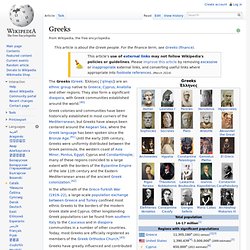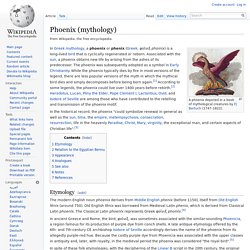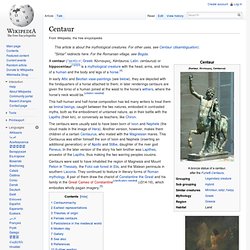

Tribes. Our Ancient People. UFO. Extraterrestrial. Greeks. The Greeks (Greek: Έλληνες [ˈe̞line̞s]) are an ethnic group native to Greece, Cyprus, Anatolia and other regions.

They also form a significant diaspora, with Greek communities established around the world.[40] Minotaur. In Greek mythology, the Minotaur (/ˈmaɪnətɔː/,[1] /ˈmɪnəˌtɔr/;[2] Ancient Greek: Μῑνώταυρος [miːnɔ̌ːtau̯ros], Latin: Minotaurus, Etruscan Θevrumineś), was a creature with the head of a bull on the body of a man[3] or, as described by Roman poet Ovid, "part man and part bull".[4] He dwelt at the center of the Cretan Labyrinth, which was an elaborate maze-like construction[5] designed by the architect Daedalus and his son Icarus, on the command of King Minos of Crete.

The Minotaur was eventually killed by the Athenian hero Theseus. "Minotaur" was originally a proper noun in reference to this mythical figure. The use of "minotaur" as a common noun to refer to members of a generic race of bull-headed creatures developed much later, in 20th-century fantasy genre fiction. Birth and appearance[edit] Chimera (mythology) The term chimera has come to describe any mythical or fictional animal with parts taken from various animals, or to describe anything composed of very disparate parts, or perceived as wildly imaginative or implausible.

While there are different genealogies, in one version the Chimera mated with her brother Orthrus and mothered the Sphinx and the Nemean lion (others have Orthrus and their mother, Echidna, mating; most attribute all to Typhon and Echidna). The Chimera finally was defeated by Bellerophon, with the help of Pegasus, at the command of King Iobates of Lycia. Since Pegasus could fly, Bellerophon shot the Chimera from the air, safe from her heads and breath.[8] A scholiast to Homer adds that he finished her off by equipping his spear with a lump of lead that melted when exposed to the Chimera's fiery breath and consequently killed her, an image drawn from metalworking.[9]
Phoenix (mythology) A phoenix depicted in a book of mythological creatures by FJ Bertuch (1747–1822).

In Greek mythology, a phoenix or phenix (Greek: φοῖνιξ phoinix) is a long-lived bird that is cyclically regenerated or reborn. Associated with the sun, a phoenix obtains new life by arising from the ashes of its predecessor. The phoenix was subsequently adopted as a symbol in Early Christianity. While the phoenix typically dies by fire in most versions of the legend, there are less popular versions of the myth in which the mythical bird dies and simply decomposes before being born again. According to some legends, the phoenix could live over 1400 years before rebirth.
The modern English noun phoenix derives from Middle English phenix (before 1150), itself from Old English fēnix (around 750). Harpy. In Roman mythology, a harpy (Greek: ἅρπυια, harpyia, pronounced [hárpuja]; Latin: harpeia) was one of the winged spirits best known for constantly stealing all food from Phineus.

The literal meaning of the word seems to be "that which snatches" as it comes from the Greek word harpazein (ἁρπάζειν), which means "to snatch". A harpy was the mother of the horses of Achilles sired by the West Wind Zephyros.[1] Hesiod[2] calls them two "lovely-haired" creatures, and pottery art depicting the harpies featured beautiful women with wings. Harpies as ugly winged bird-women, e.g. in Aeschylus' The Eumenides (line 50) are a late development. Roman and Byzantine writers detailed their ugliness.[3] Mythology[edit] A medieval depiction of a harpy as a bird-woman In this form they were agents of punishment who abducted people and tortured them on their way to Tartarus.
Satyr. The satyrs' chief was Silenus, a minor deity associated (like Hermes and Priapus) with fertility.

These characters can be found in the only complete remaining satyr play, Cyclops, by Euripides, and the fragments of Sophocles' Ichneutae (Tracking Satyrs). The satyr play was a short, lighthearted tailpiece performed after each trilogy of tragedies in Athenian festivals honoring Dionysus. There is not enough evidence to determine whether the satyr play regularly drew on the same myths as those dramatized in the tragedies that preceded. The groundbreaking tragic playwright Aeschylus is said to have been especially loved for his satyr plays, but none of them have survived. Attic painted vases depict mature satyrs as being strongly built with flat noses, large pointed ears, long curly hair, and full beards, with wreaths of vine or ivy circling their balding heads. Pan (god) In Greek religion and mythology, Pan (/ˈpæn/;[1] Ancient Greek: Πᾶν, Pān) is the god of the wild, shepherds and flocks, nature of mountain wilds, hunting and rustic music, and companion of the nymphs.[2] His name originates within the Ancient Greek language, from the word paein (πάειν), meaning "to pasture.

The dying god. Mythological Creatures of Greece. Centaur. Brooklyn Museum - Centauress - John La Farge - overall.

Greek horse myths. Origins & development of the piano. Fortepiano.